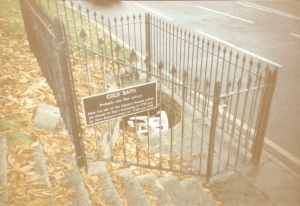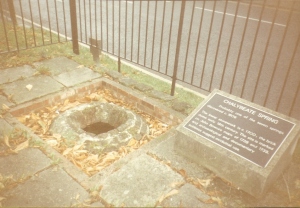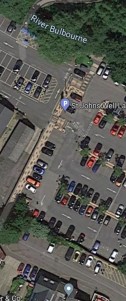Monthly Archives: December 2023
Noted springs and wells around Tunbridge Wells: The Chalybeate spring and the Burnt House Spring
Undoubtedly the most famous healing water in Kent and perhaps one of the most well known in Europe is The Chalybeate Spa. Its discovery can be outlined briefly as follows, being uncovered by chance in 1609, by Robert Dudley, whilst he was riding back to London, stopping by a densely wooded hollow, beside a stream. Here he noticed a reddish-rust coloured pool. Dudley being a hard drinker was familiar with the fashionable European spa waters, and noticed a resemblance! Indeed, upon drinking some, he found that the water was also similar in taste. Realising its potential, he took a sample to his physician for analysis. This showed traces of vitriol ferrous sulphate, then considered to have some medicinal power. Such vindicating news pleased Dudley, who returned the following summer to undertake a treatment, after which he found himself healthier. Perhaps the water was lengthened his life, for he lived to 84! Fortunately, exploiting the spring was easy, as it lay within the Abergavenney Estate, who being an acquaintance of Dudley, and subsequently the pool was cleared and cleaned out, and a well sunk, to improve the quality. This work revealed that the waters arose from seven springs.
By 1619, the whole area was enclosed in, and marked off with wooded rails. Already, it was much frequented, but a lack of suitable accommodation, affected trade. Even Henrietta Maria, visiting for six weeks in 1630 to recover after the birth of the future Charles II, had to camp out at Bishop’s Dun Common, like the rest of her court. This, and the increased interest as a result of a treatise extolling their virtues by a Dr. Rowse, heightened these accommodation problems, so Assembly room, walks and accommodation constructed and by the late 1600s stalls and facilities and a season between May and October established. As the original 1780 Bath House only administered cold baths, new heated baths were constructed in 1802-4. The remains of this later bathhouse are now beneath Boots the Chemist. A Victorian pump room was constructed at the south end of the Pantiles, with a fountain, reading and retiring rooms. These would appear to have been too late a development, soon falling into disrepair, finally being demolished in 1964. Despite its decline, the waters can indeed are still served by a dipper from Easter to October.
Other relics of the spa’s can be found such as one of the earliest cold baths and one of the original brick-lined shaft wells. The cold bath is now dry and filled with litter, but the well may have some trace of water. Beside each are suitable plaques describing their histories:
“COLD BATH Probably mid-18th Century. Near the site of the Dipper’s Houses which are shown on Kip’s engraving of 1718 and on John Bowra’s maps of 1738 and 1739.
CHALYBEATE SPRING: Probably one of the seven springs discovered c. 1606. The lower stonework is c.1700: the brick dome early 19th century. The site is marked on John Bowra’s map of 1738 and 1739, and archaeological and documentary evidence suggests medicinal use.”
A local legend records the origins of the waters. The Devil, appearing as a beautiful woman, tried to distract the St. Dunstan at his forge, being far too clever and pious to be put off he saw his cloven hooves, turned around and clasped his nose with his red hot tongs. Flying off in a furious rage he found the springs and upon cooling his nose produced its iron waters. A story also associated with the Roaring spring in Sussex.
On the road to Pembury was another attempt to exploit the chalybeate springs of the area. Called Burnt House spring Britton in their 1816 Descriptive Sketches of Tunbridge Wells and the Calverley Estate notes it is:
“…situated in a little dell, in a romantic spot to the right of the road leading from Tunbridge Wells to Pembury. It is a good chalybeate, and the iron is in a state of carbonate. This spring rises rapidly into a stone basin, placed in the centre of a circular excavation, about ten feet in diameter and six or eight feet deep, which is bricked round, and with the remains of stone steps leading down to the basin at the bottom. This spring, therefore, has clearly been, at some time, made use of as medicinal water. It was accidentally discovered choked up with rubbish. The country about Tunbridge Wells abounds with springs of this character.”
When the estate was developed into Dunorlan Park Henry Reed the spring was retained and improved. The site, possibly with the fabric oldest in the area, arises in a square chamber with a circular basin surrounded by bricks; the water then flows down a channel into as drain. Four large stone steps lead down into the chamber and the hole is brick lined. In a way this is probably what the original development of the chalybeate spa was.
Taken from Holy wells and healing springs of Kent
A lost Hertfordshire well – St John’s Well, Berkhampsted
The town once boasted the most famed well in Hertfordshire, which was called St. John’s Well. The earliest dedication would appear to be St. James, as it was associated with a chapel to the saint on the south side of the main road. Apparently it gained the other dedication when a guild of the brotherhood of St. John the Baptist took over its care.
Thus its history is a little confused and probably tainted by antiquarian half truths. For example after the establishment of nearby monastic society in the Saxon period, the monks were obviously distressed to find such pagan activities continuing. Rather than forbid any such activity, one monk, through a dream, was told the solution. He should re- dedicate the well to St. John the Evangelist, and thus create a Christian focus for the sick who bathed here. Although successful, it did not apparently stop all such ‘pagan’ worship. Indeed, in the late 1100s it is reported that Hugh of Grenoble, Bishop of Lincoln journeyed the considerable distance to prevent „pagan‟ activities such as dressing the well, although there is no record of this in the appropriate documentation of the period. Certainly a fair on St. James’s Day may have been established to overcome these problems. Travelers of all types refreshed themselves at the well, benefiting from the healthy waters, and would rest at the monks’ hospitality: little booths being built to house travelers.
Its waters were believed to cure a variety of ailments: eye soreness, Kings evil (scrofula), and leprosy. Suffers from the latter problem apparently were looked after in a leper hospital. All these ailments were commonly experienced by the crusaders, and hence it received heavy patronage during this period. Water was even carried to those unable to reach the well, receiving an extra blessing from the conferred to the person. This however was frowned upon and fines were imposed for such activities, such as in the 1400s when two officials of the Portmote Court were appointed to protect the spring (then the town’s principal supply) from such spoilage. The last noted of these officials was a Geoffrey Fitz Piers, of the said brotherhood.
When the Reformation dissolved the monastic society; the monk’s houses, landscaped gardens and the spring, became broken down, derelict and overgrown. With the lack of any Christian overseers, apparently the old ways resurged. People began to assemble at night, to undertake rituals. In the 17th century a local physician, Dr. Woodhouse, used the holy water to use against frenzy: exorcising evil spirits. Despite containing ‘spa salts’, it was not exploited and 1865 the water was declared by the local authorities to be unfit for drinking, and should be used only for gardens.
Until the 1930s the well’s water still flowed over stones and down a shallow channel along St John Well’s Lane when a post office was built over the site of the leper. Now the post office is gone and housing over the site. The well being lost forever.
Taken from Holy wells and healing springs of Hertfordshire.
The ancient, holy and healing wells of Bodmin Part four: St Petroc’s Well
 The last notable well is the town is that found in the local park. This is what is now called St Petroc’s Well has gone through a number of name changes. In 1635 it was called St Guron’s well and in 1639 St Jerome’s Well although this may itself derive from a mispronouncation of the Guron! Thus there appears to have been some confusion with the site by the church and their names appear to have been interposed. Hence many of the early records such as Quiller-Couch miss it.
The last notable well is the town is that found in the local park. This is what is now called St Petroc’s Well has gone through a number of name changes. In 1635 it was called St Guron’s well and in 1639 St Jerome’s Well although this may itself derive from a mispronouncation of the Guron! Thus there appears to have been some confusion with the site by the church and their names appear to have been interposed. Hence many of the early records such as Quiller-Couch miss it.
However, the Petroc association is supported by the well arising in the lands of a monastery said to have been founded by St. Petroc in the 6th century. Tanner records British monks following the rule of St. Benedict about 936. The community existed until about 1124 when it was re-formed for Augustinian Canons. Priory House was built on the site and remains today at the edge of the park.
A marvelous discovery
A wooden statue of St. Mary was actually concealed inside the well to protect it from Cromwell’s troops. Incredibly it was only found at the very beginning of the twentieth century. After minor repairs and redecoration at Buckfast Abbey, it was returned to Bodmin where it is found in St Mary’s church, whether it was originally from there or the monastery is unknown.
The well today
The well arises in a stone lined chamber at the end of a streamlet beyond the stone channel edge. It is often covered in water as it was nearly completely cover when a flood alleviation system was established in 2001 by the Environment Agency such that only around 30% of the stone structure is visible. A secret mysterious place in a modern park.





